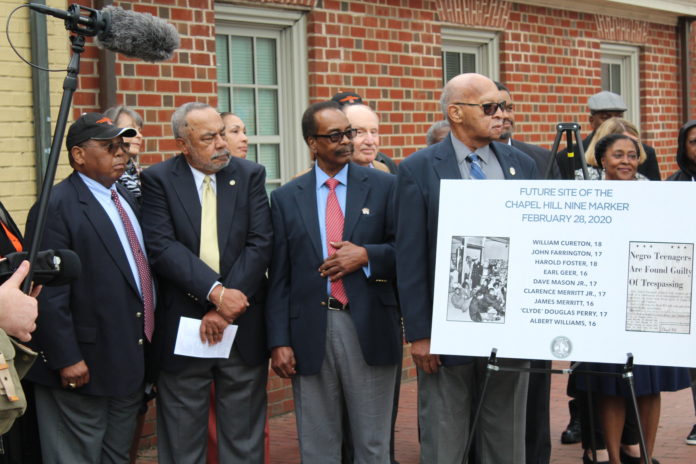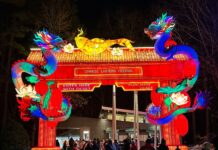
With a ceremony on February 28, the town of Chapel Hill has honored a group of nine Lincoln High School students who 59 years ago followed the lead of the Greensboro Four and staged a sit-in at a drugstore on Franklin Street.
In 1960, the Chapel Hill Nine, as they would become known, walked into the Colonial Drug Store and took seats at a counter. Though they often bought ice cream there and their families would buy medicine on credit from the owner, familiarly known as Big John, the nine students were denied service, arrested and convicted of trespassing.
The students’ action marked the start of a decade of protests against segregation in Chapel Hill. A second sit-in followed in July, theaters were desegregated two years later and, in 1963, a biracial group of hundreds supporting integration marched through the town. Chapel Hill-Carrboro City Schools (CHCCS) finished desegregation in 1966.
The Colonial Drug Store is now the West End Wine Bar, outside of which a plaque honoring the Chapel Hill Nine will be located, to be unveiled at the 60th anniversary next year.
The dedication effort was spearheaded by the Historic Civil Rights Commemoration Task Force that Mayor Pam Hemminger formed in the fall of 2017. Last summer, the task force, which researched town history to make a timeline, gave the town council several recommendations, such as dedicating a historical marker to the Chapel Hill Nine. The town council approved a plan for the historical marker last November. The timeline has been published online and a large copy of it printed for the public library.
“The most important thing we accomplished was the full recognition that the Chapel Hill Nine began [the town’s anti-segregation protests] on this very spot,” former mayor Kenneth Broun, the task force chair, said at a ceremony on the Franklin Street sidewalk where the plaque will be.
Town employee Jerry Neville, a member of the task force, pointed out some other results stemming from the Chapel Hill Nine’s actions: the University of North Carolina at Chapel Hill’s (UNC) admittance of Sherdenia Thompson, a Lincoln High School graduate, as the first African-American woman accepted as a freshman; Dean Smith’s recruitment of Charlie Scott as UNC’s first black basketball player in 1966; and the town’s election of Howard Lee, the first black mayor in a majority-white Southern city, in 1969.
“I am not just proud of the Chapel Hill Nine, but I am proud of Chapel Hill,” Danita Mason-Hogans of Duke University’s Center for Documentary Studies said. She is a daughter of one of the Nine and a member of the task force.
“The first sit-in by high-school students was right here in Chapel Hill. I want other youth to be inspired by what was done,” she added. “Let Chapel Hill be a model of collaboration and telling the true history of the civil rights movement.”
The Chapel Hill Nine were known to gather at a rock wall on McDade Street in Chapel Hill. Molly Luby, of the public library and part of the task force, said at the ceremony that the group planned the sit-in there and “did some other things, too.” The crowd laughed.
Recalling the historic rock wall, the four living members of the Chapel Hill Nine and family members or representatives of the other five placed one rock at the future plaque’s location for each member of the group. A sermon by the Reverend Norris Trice also dedicated the site itself to the Chapel Hill Nine.
The gathering then turned the corner onto Roberson Street to enter the First Baptist Church of Chapel Hill. Outside the church was a quilt made by Northside Elementary School students reading, “Lift Every Voice” and “Be the Change.” At the front of the church was a large printed copy of the timeline of 1960s events.
The four living members of the Chapel Hill Nine were honored with individual plaques, the families of all nine were given certificates and candles were lighted to remember the deceased: William Cureton, John Farrington, Harold Foster, Earl Geer and Clarence Merritt, Jr.
Chapel Hill Fire Department Chief Matt Sullivan reminisced about Albert Williams, Chapel Hill’s first black firefighter and a member of the Chapel Hill Nine, and presented him with the first of the plaques.
CHCCS Superintendent Pamela Baldwin said, “The story of the Chapel Hill Nine was not a one-day event.” Recognizing the following decade of protests in the town, she gave a plaque to “Clyde” Douglas Perry, one of the Nine, who worked in finance for CHCCS for 27 years.
Town councillor Alan Buansi honored James “Jim” Merritt, who Buansi said “started his service well before the military” by taking part in the Colonial Drug sit-in, and then went on to serve on the town council.
Finally, North Carolina Central University (NCCU) archivist Andre Van presented NCCU alumnus David Mason, Jr. with a resolution from university chancellor Johnson Akinleye commending him and the rest of the Chapel Hill Nine for “displaying courage in the face of adversity.”
Mason’s granddaughter, Akanke Mason-Hogans, introduced UNC African-American-history professor Reginald Hildebrand.
“It’s not a new thing to be young and politically active,” Mason-Hogans said, adding that it is important to have events like these for everyone to know about their history.
In a keynote speech, Hildebrand said that young people today may not understand why the Chapel Hill Nine’s action was important. Recalling Joshua 4:6–7, in which children ask “What do these stones mean?” Hildebrand said that children now wonder, “How could it be that young men, by sitting in a both in a drug store—how could that have caused such a fuss?”
“It is our obligation not to forget the significance of what they did,” Hildebrand said, describing the disturbing reality in which African Americans lived because of Jim Crow laws. “The marker we erect will be a milestone on a journey” that still continues.
The general mood of the evening was more uplifting, however. Celebratory songs throughout the evening included “Lift Every Voice and Sing,” “Reach Out and Touch (Somebody’s Hand),” “My God Is Real” and “To Be Young, Gifted and Black.”
The task force’s timeline about civil rights movement in Chapel Hill is available at https://chapelhillhistory.org/.











